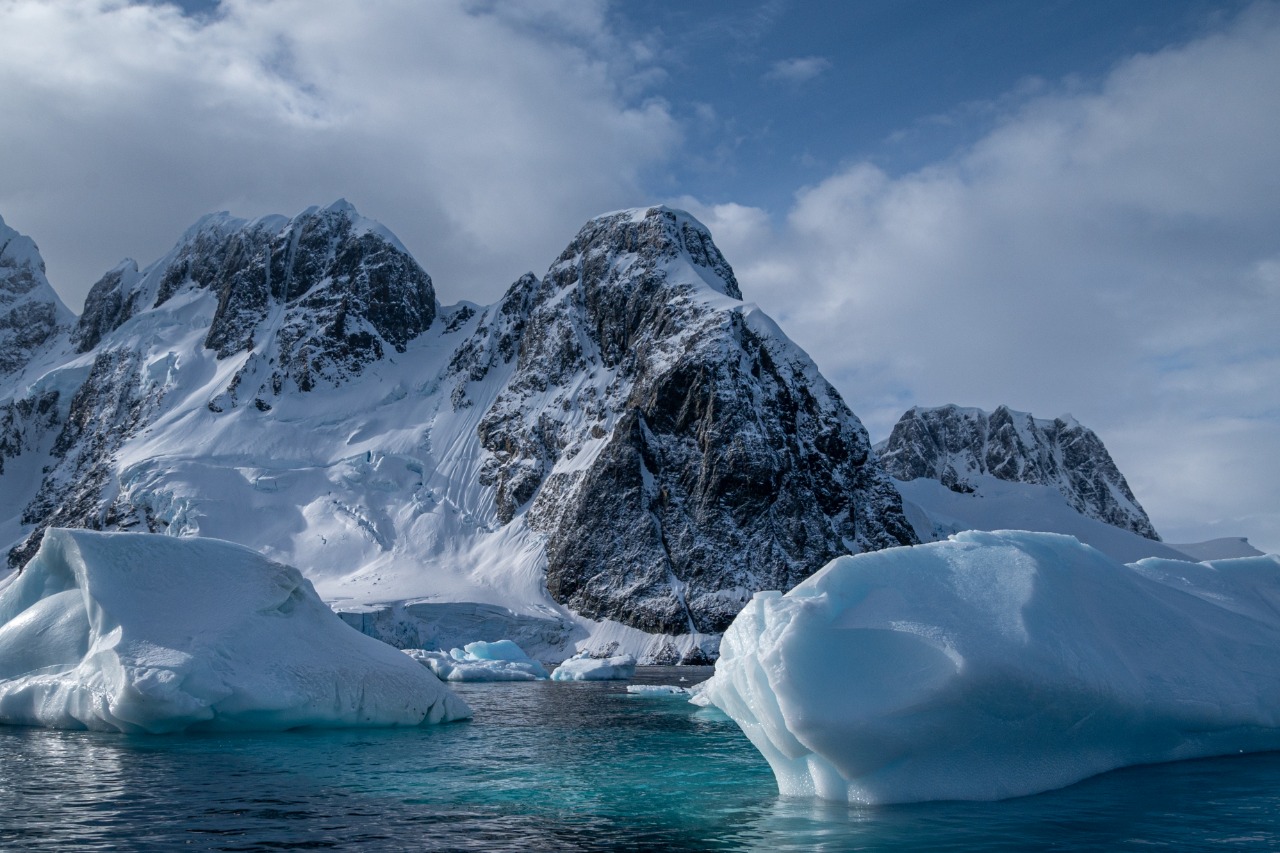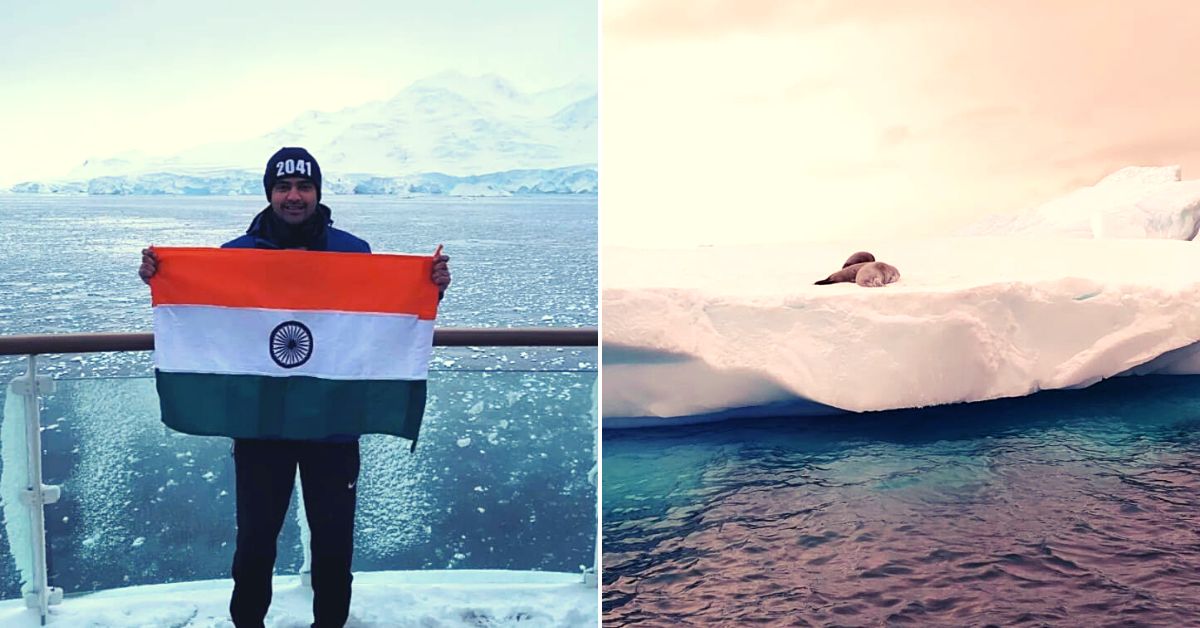In March 2022, Anup Misal, a 23-year-old working with the flower and farm waste recycling startup Phool.co, represented India at the 2041 Climate Force Antarctica Expedition organised by the 2041 Foundation. It’s a non-profit founded by Sir Robert Charles Swan, the first person in history to walk to both the North and South Poles. Anup was among 138 participants selected from 17 countries to start the 12-day expedition to Antarctica from March 17.
(Image above of Anup Misal on the left and of a Weddell seal, Location: Port Charcot, on the right)
The expedition aimed to study the impact of climate change on Antarctica. Anup was selected for the programme after a gruelling year-round application process with sponsorship coming from various organisations led by Datar Security and Service Group (DSSG), a private security firm. Support also came from the private security company’s group CEO Adel Singh Bhinder and Phool. co founder Ankit Agarwal.
Earlier this month, he spoke to The Better India and shared some photographs, highlighting his experiences in Antarctica, and how the vagaries of climate change are affecting its ecosystem.

Journey to the end of the earth
It was a year before the expedition in March 2021 when he first read about the 2041 Climate Force Antarctica Expedition. “Swan started this mission to create a cohort of climate ambassadors who will raise their voices and help save Antarctica. This expedition was about taking us to Antarctica and witnessing the effects of climate change first hand,” says Anup.
He began his journey by taking a flight from Delhi to Buenos Aires, Argentina, via Amsterdam. From Buenos Aires, he took another flight to Ushuaia, the capital of Tierra del Fuego, an archipelago at the southern tip of South America. Ushuaia serves as a port of call for Antarctic cruises. There, he was quarantined for three days because of COVID-19 protocols, besides undergoing mandatory testing. After testing negative, Anup boarded the ship Ocean Victory and set sail for Antarctica on 18 March.
“From Ushuaia, we travelled through the Beagle Channel, a long and narrow interoceanic passage. After crossing this, we went through the Drake Passage, an infamously rough passage given how the currents at this latitude meet no resistance from any landmass, anywhere on the planet. The tides were about 20 feet high,” he recalls.
Following two days of sailing, the ship finally reached Antarctica.
“It was -32 degrees Celsius outside and snowing. Despite how cold it got, people stood outside for a good 30 minutes just to capture a glimpse of the first iceberg. Temperatures would drop further into the -40s [degrees Celsius] with the wind chill accentuating the cold. This chill hits your face directly. Given that the ship is running at a speed of 10-11 nautical miles when the wind chill hits, it’s impossible to open your mouth. People on board even stopped taking pictures beyond a point because if the gloves went off, your fingers would get frozen,” he says.
After crossing Ross Island, the first place in Antarctica they entered was Fournier Bay, an 8 nautical miles long and 3 nautical miles wide bay indenting the northeast coast of Anvers Island. Here, they spotted the first Gentoo penguins and humpback whales. After passing through Fournier Bay, the ship proceeded to Lemaire channel and reached Pleneau Island on 22 March.
“Here, we saw penguins moulting and their shore landings. We also encountered the iceberg graveyard and saw a massive iceberg flip and break in real-time. It’s an astonishing sight given how massive they are. You can only see a tenth of it with the rest underwater. Watching a large iceberg melt, break and flip over was my real introduction to the impact of climate change on landmasses like Antarctica. Following this, we made our way to Port Charcot, the place where the first researchers had come to study Antarctica. The island was named after the French explorer Jean-Baptiste Charcot, who was the first one to arrive,” notes Anup.
Here they saw crabeater seals, and leopard seals on floating slabs of ice, and studied krill activity and how important they are for the Antarctic ecosystem. Krill are small semi-transparent crustaceans like a shrimp, about 6 cm (over 2″) in length, and play a very central role in the ecosystem. If their activity gets disturbed, it impacts the whole wildlife ecosystem. Penguins consume the krills, while the seals consume the penguins, and so on.
‘What I learnt on this expedition’
“Every day, we used to do shore landings, wherein we had to go get into those zodiacs (small rafts carrying about 10 people), go around Antarctica along the Southern Ocean, do whale spotting, learn about penguin societies, understand how whale surveys are done, learn about how the Orca (Killer Whale) travels and learn about the seals. We were even given a guide on how birds like the albatross when they first come down to Antarctica, live, survive and hunt for their food. We also learnt about krill activity in the region. In the evening, they would get off their zodiacs, land on these bases and go for hikes on Charcot base,” he recalls.
On 24 March, they were at NEKO Harbour passing through a whaling station where millions of whales were once slaughtered here. They were then taken to Brown Station, an Argentinian base of research. Here, they studied penguin societies in the region, the history behind the base, and the purpose behind its establishment. She saw penguin societies getting affected by the ocean waste flowing into Antarctica from around the world. One estimate suggests that “the sea around the Antarctic Peninsula contains an average of 22 pieces of microplastic per litre.”
“I saw these penguins consuming that waste and some lying dead. Mind you, this was when they were moulting, which is a time when those penguins don’t have food for weeks. They have to survive, shed their skin and be ready for the winter months coming along the way. Since we were part of the last expedition to go that year, we saw a lot of penguin societies like the chinstrap penguins, gentoo penguins, Adélie penguins, etc. Finally, we hit Deception island, a place with an active volcano and a place where we did the polar plunge. After this we returned to Argentina via the Drake Passage,” he says.
Elaborating on his learnings, he says one of the most horrific sights he saw was rain in Antarctica, while the ship was on its way to Deception Island. “This event highlighted the importance of urgent climate action given the rising temperatures. This is not supposed to happen in Antarctica. Rain has consequences on ecosystems, particularly on penguin colonies, and on the ice sheet mass balance,” he adds.
Antarctica is a continent which hasn’t seen wars, besides remaining barely touched by humans on a large scale. “We must keep that continent safe. We want to save Antarctica because this is the last resort. If it completely melts, just consider that a significant part of the world will be underwater. That’s the last resort, the last icy heartbeat of our planet,” he says.
Another key learning is the need to respect the wildlife around him. Penguins, for example, knew how to respect the space occupied by the participants of the expedition.
“They used to walk in a straight line wherever they went with each penguin, maintaining a 5-metre distance with the humans there. We were not allowed to go with our GoPro or selfie sticks near them. The expedition supervisors were very strict about enforcing this rule. Also, what I learned through this expedition was the number of organisations working to preserve the habitats of these animals. Some have managed to revive the number of seals, whale colonies that were almost extinct thanks to poaching, etc. There is hope,” he concludes.
(Edited by Yoshita Rao)
Like this story? Or have something to share? Write to us: contact@thebetterindia.com, or connect with us on Facebook and Twitter.
If you found our stories insightful, informative, or even just enjoyable, we invite you to consider making a voluntary payment to support the work we do at The Better India. Your contribution helps us continue producing quality content that educates, inspires, and drives positive change.
Choose one of the payment options below for your contribution-
By paying for the stories you value, you directly contribute to sustaining our efforts focused on making a difference in the world. Together, let's ensure that impactful stories continue to be told and shared, enriching lives and communities alike.
Thank you for your support. Here are some frequently asked questions you might find helpful to know why you are contributing?

